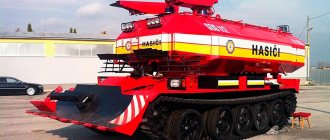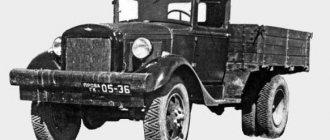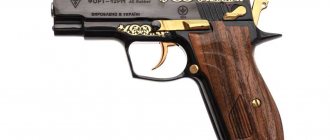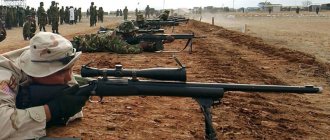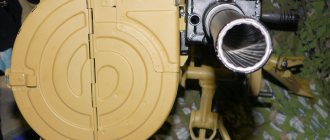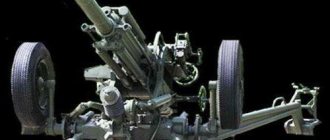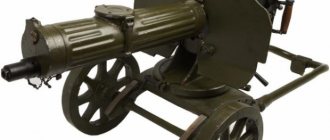| 24.07.2020 |
Fires can occur in areas where there are no roads. In such a situation, there is nothing left but to use aerial equipment or all-terrain vehicles. Operating airplanes and helicopters is too expensive, so if you can get by using all-terrain equipment to extinguish hard-to-reach fires, then special tracked fire engines are used.
Purpose
GPM-54 is a heavy-duty vehicle that is used when extinguishing fires of increased complexity in extreme conditions. In order to be used at military facilities, the body is protected by armor. Water, air-mechanical foam and powder are used as the main fire extinguishing agents.
Since the vehicle was developed on the basis of a tank, the designers managed to equip it with the most effective means of protecting the crew when working in difficult conditions. The main advantage of the GPM-54 firefighting tank is the ability to ram a burning object and extinguish the fire from above.
Initially, the main purpose of this machine was to fight fire in forests. Sitting in the cab, firefighters are absolutely safe in the face of the elements. Thanks to the bulldozer blade, it is possible to fell doomed trees without the use of additional equipment, thereby speeding up the extinguishing process. During tests, this machine showed its suitability for use in fires in dense buildings when it is necessary to block burning structures in order to prevent the spread of fire to neighboring objects.
The basic equipment of the GPM-54 fire tank includes the FVU-15 filter-ventilation unit, thanks to which it was possible to expand the functionality of the vehicle and use it in conditions of combustion of radioactive substances and potent poisons.
Universal Soldiers: Tracked Firefighting Vehicles
GPM-64. Source: fireman.club
For forests and artillery depots
In previous parts of the history of armored tracked fire fighting vehicles, we talked about the GPM-54, the most popular fire fighting tank in the world.
The vehicle was and is still produced to order at the Lvov Armored Repair Plant based on the T-54 and for a long time was the only one in its class in the country. GPM-54 was used to extinguish fires in the most extreme conditions, primarily in artillery depots.
The machine was not perfect in execution, which is why people sometimes died. So, in 1982 in Yoshkar-Ola, during the elimination of a fire at an artillery warehouse, two GPM-54s burned down along with their crews.
For less severe conditions, light tracked armored vehicles were intended, capable of getting through forest debris and, if necessary, creating a mineralized strip around the fire.
The first in the domestic line of fire fighting equipment are the unarmored all-terrain forest fire fighting vehicles VPL-149 and VPL-149A.
VPL-149. Source: fireman.club
This is a universal tracked vehicle capable of transporting up to 6 personnel and more than 300 liters of water with foaming agent. The equipment is based on the floating all-terrain vehicle GT-SM (GAZ-71) of the Zavolzhsky Crawler Tractor Plant or, in modern terms, GAZ-34039.
VPL is one of the most common tracked fire engines, well adapted to extinguishing forest fires - on board there are two motor pumps, a fire hose, 60-meter pressure hoses, chainsaws, motor pumps and a disc plow for laying mineralized strips. However, a relatively small supply of water reduces the autonomy of VPL-149.
The next modification, which significantly expanded the capabilities of the vehicle, was the VPL-6. The developers simply attached a one and a half ton tank on wheels to the tractor and increased the capacity of the tanks on the chassis itself to 700 liters. In this configuration, the tracked GT-SM could no longer float without first getting rid of the trailer.
LPA-521. Source: kargoteka.infoThe Rubtsovsky branch of Uralvagonzavod in the Altai Territory, which produces tracked vehicles based on infantry fighting vehicles, is responsible for heavier class equipment.
The recipe is simple - the chassis is supplemented with a seventh road wheel and the engine is replaced with a more durable YaMZ-238BV diesel engine with a power of 310 hp. With. According to this scheme, the universal snow and swamp-going chassis 521 M1 is born in Rubtsovsk, which is externally related to its military ancestor only by the road wheels. The tracks, by the way, also had to be replaced with wide 700 mm ones with an increased resource.
A lot of equipment is produced on the basis of this chassis, but within the framework of the article, the forest fire unit LPA-521, serial production of which started relatively recently - in 2010, is of interest.
This is a true universal soldier, capable of much in the area of a natural fire disaster.
In addition to small fire equipment (backpack fire extinguishers, incendiary devices, protective equipment, etc.), a massive pusher wedge is hung on the nose of the vehicle. With this blade, the machine is capable of forming a 3.2-meter mineralized strip at speeds of up to 5 km/h, and with the tail PLC-2A - a two-meter furrow. At the same time, the tracked vehicle carries up to 4 tons of water and six rescuers. The cabin has two berths.
For the most severe cases
A whole line of equipment produced at the Muromteplovoz enterprise can be considered similar in build to the Rubtsovsk fire truck.
The MT-LBu all-terrain vehicle with a set of minimal changes is taken as the basis. In accordance with good domestic traditions, the fire truck has a long name - MT-LBu-GPM-10.
MT-LBu-GPM-10. Source: industrialmachine.ru
MT-LBu-GPM-10. Source: wikimedia.org
The all-terrain vehicle has 4 tons of water, 300 liters of foaming agent, a fire monitor, a bulldozer blade and bulletproof armor that allows it to climb into forest fires. An external body irrigation system allows you to save the car in the most extreme conditions. The army tractor also became the basis for a mobile fire pumping station, which allows pumping water from open sources over several hundred meters.
An interesting design option is an aircraft controller for reconnaissance in a fire, topographic location, target designation and adjustment of aviation actions.
Firefighter aircraft controller. Source: muromteplovoz.ru
The aircraft controller's cabin with a full set of radio communications was specially placed in the MT-LBu building. The armored hull of the tractor, if something happens, can safely survive the fall of several tons of water from an air fire tanker. At the same time, the aircraft controller himself did not lose the ability to fight fire - the water tanks and carriages were preserved.
The latest modification of the MT-LBu for the needs of firefighters was the “Special Amphibious Tracked Fire Engine,” which can be identified by its characteristic tanks located directly on the roof. The vehicle is equipped with modern means of communication and navigation, as well as a lot of specific fire-fighting equipment - the list includes a soil thrower, an incendiary apparatus, individual gas and smoke protection kits "Chance-E" and much more.
Special amphibious tracked fire engine. Source: muromteplovoz.ru
The MT-LB light artillery tractor is produced in Murom, and it has also become the main one for a fire truck.
This is a specific machine belonging to the class of fire tractors. The Motolyga was equipped with a bow blade, a plow in the stern, and an excavator bucket on the roof. MT-LB-LP can both make mineralized strips in a burning forest and clear away rubble for the passage of lighter equipment. If necessary, the design allows you to attach a four-ton trailer with water to the armored tractor.
"Rubezh - 4000". Source: stroyland.bizLet's take a little break from military equipment and consider a firefighting tractor, created on the basis of the MSN-10 skidding tractor.
This specific unit is produced at the Altai Self-Propelled Vehicles Plant in Barnaul, which is famous for tracked vehicles for forestry. The fire version received the beautiful name “Rubezh - 4000”, where the number indicates the number of liters of water on board. The machine is equipped in the best traditions of the genre with a moldboard, plow and pump. But the body is not armored, which seriously limits the combat effectiveness of the unit in a war against forest fire.
And again tanks
In the post-Soviet space, one of the leading manufacturers of heavy armored fire fighting equipment is the Lvov Armored Plant.
It is currently producing to order the massive GPM-72 firefighting tank, which looks more like a van on tracks. Engineers took into account the experience of the not-so-perfect predecessor GPM-54 and thoroughly redesigned the design.
First of all, the tank was equipped with a life-saving body irrigation system, and was also equipped with a tank for 20 tons of water at once - the GPM-54 had only 9 tons. The range of the fire monitor has also increased. The water flow goes 100 meters, and the foam flow 60 meters. This is a very important parameter for the vehicle, designed to combat fires in artillery arsenals. This range is largely due to the powerful imported pump FPN Ziegler-6000-2H.
GPM-72. Source: fireman.club
GPM-72. Source: golosua.info
The crew consists of three people - this allows the vehicle commander not to be distracted by controlling the carriage, which was inevitable in the two-seat GPM-54.
If necessary, the fire tank is capable of evacuating up to 6 people from a disaster zone - a special compartment is provided for this. Ukrainians first demonstrated a fire tank based on the T-72 seven years ago in Astana at the KADEX-2014 arms exhibition. This was an initiative development of the Lvov plant.
GPM-64. Source: fireman.club
But the development of a firefighting tank on the native Ukrainian T-64 chassis was already carried out at the Kharkov Armored Repair Plant (KhBTRZ).
The vehicle, under the name GPM-64, was built in 2010 and was even tested while extinguishing an oil depot near Kiev and military warehouses in Lozovoy.
The differences from the analogue from Lviv are not only in the chassis used, but also in the larger volume of the tank for 25 cubic meters of water, as well as in the absence of a compartment for evacuees. Otherwise, the Kharkov resident is similar to the Lviv fire tank. We must give credit to the KhBTRZ engineers; their fire tank turned out well.
To be continued…
Operation history
In the first ten years after release, the GPM-54 was supplied exclusively to the military. Since 1984, four vehicles have been on duty at the Baikonur cosmodrome. At the end of the 80s, it was decided to expand the scope of use of this type of PA and transfer the tracked vehicle to the balance of strong points at the facility and specialized units for extinguishing natural fires. In 1986, tracked vehicles worked in the “exclusion zone” during the accident at the Chernobyl nuclear power plant.
Due to its characteristics, the GPM-54 is still considered an indispensable equipment in missile and artillery ammunition depots. It was used to extinguish the 61st arsenal of the Ukrainian Armed Forces in 2008 (Lozovaya, Kharkov region) and during the liquidation of an accident at the 6th arsenal of the Ukrainian Armed Forces in 2022 (Druzhba, Chernihiv region).
Fire wagon diagram
photo: fire-truck.ru
Pump-line fire truck. There were many options for special carts, in this picture we see, among other things, hydrants, a fire hook, a water pump and a ladder.
To the fire
photo: kapuchin.livejournal.com
Fire crew. Moscow, 1900.
Horse-drawn carriages of the fire service of the Russian Empire. Very soon horse traction will be replaced by internal combustion engine traction
photo: humus.livejournal.com
"Daimler-List"
photo: fort-i-ko.livejournal.com
The first fire truck for Russia "Daimler-List". Photographed in Moscow against the backdrop of the fire station on Prechistenka. Photo from 1908.
"Commer-Car"
photo: humus.livejournal.com
Fire truck of the Kommer-Car system in St. Petersburg. 1911
Manual fire pump
photo: po-bereg.ru
Two-handed fire fighting pump. The beginning of the last century.
"Lesner"
photo: carakoom.com
Fire truck "Lesner".
Russo-Balt D24-40
photo: carakoom.com
Russo-Balt D24-40.
Fire trucks of the USSR
This period was marked by a transition to a qualitatively and technically new level. In addition to their valor and selfless work at the risk of their lives, firefighters received another bonus: they began to receive equipment that was relevant at that time. What distinguished the Soviet period from the modern and previous ones was that 98-99% of the equipment was domestically produced. The trucks were unified as much as possible and were built on the basis of civilian and military vehicles, which reduced their cost and made it possible to introduce vehicles in large quantities throughout the USSR.
Fire truck Ya-3
photo: carakoom.com
Fire truck produced by Avtopromtorg. The chassis of a three-ton truck from the Yaroslavl plant Ya-3 is used. Produced from 1925 to 1928.
Fire truck (AMO-F15 base)
photo: carakoom.com
Fire truck based on AMO-F15. The first Soviet truck, mass-produced by the Moscow plant AMO (Automobile Moscow Society).
PMG-1
photo: carakoom.com
Subsequent development of the automotive industry to meet the needs of fire chiefs. PMG-1 – fire truck. Produced from 1932 to the 40s.
Modifications
Today there are three modifications of the fire tank in operation:
- GPM-54 with bulldozer canopy BTU-55.
- GPM-54-01 with bulldozer canopy TBS-84. In development since 2005.
- GPM-54M with an automatic spray water supply system.
The last modernization was carried out in 2022, and the car received imported hydraulic equipment.
The main differences between the basic GPM-54 and the modernized GPM-54-01
| GPM-54 | GPM-54-01 | |
| Number of combat crew seats | 2 | 2+1 |
| Hydraulic system | · hydraulic distributor GA-86 – 1 pc.; · manual hydraulic distributor R-102 – 3 pcs. | · electric hydraulic distributor – 4 pcs. |
| Bulldozer equipment | · ST-16M starter; · spontaneous lowering when the drive is deactivated; · distributor GA-86. | · drive from a pump; · pump PGP511А0100 in the general hydraulic system; · presence of hydraulic locks; · Parker distributor. |
| Monitoring the monitor | · operation from a common pump. | · own monitor drive pump. |
| Body lift | · presence of high bending moments of hydraulic cylinder rods; · operation of the drive is associated with the activation of the fire pump; · a pipeline break entails a free fall of the body; · drive from the pump. | · use of hinged supports; · blocking of the pump when the lift drive is activated; · body fall hydraulic clamps; · operation from the main and emergency pumps of the hydraulic system. |
| Lighting systems | · lamps МН-26-012 – 6 pcs. | · LEDs AL 370 – 6 pcs. |
Taking a military tank as a basis, the engineers subjected it to a number of changes:
- an armored cabin was installed in the workplace area;
- an armored water tank with 9 cubic meters was placed above the cabin;
- a folding body with a powder installation and fire-fighting equipment was installed on the roof of the power compartment;
- the fire monitor was placed on top of the tank;
- compartments for fire hose reels and a pump are provided behind the water tank;
- a motor-transmission unit was located under the pump-hose compartment;
- Bulldozer equipment was secured in the bow.
History of the development of fire trucks in the Russian Empire, USSR and Russia
Fire trucks and vehicles of the Russian Empire
Formation of technical support for fire defense of the Great Empire. From horse-drawn carriages of firefighters to the first cars. But what remained constant were the people. They, as never before, were real fighters, knights, ready to fight one of the most insidious and dangerous enemies, who knows no mercy and pity - with fire!
Horse traction
photo: fire-truck.ru
Horse-drawn fire escape. Water was pumped from the barrel using hand pumps.
Performance characteristics of the firefighting tank GPM-54
| GPM-54 | GPM-54-01 | |
| Chassis | T-54 (T-55) | |
| Engine | B-55 | B-55 V-twin 4-stroke |
| Engine power, hp | 580 | |
| Dimensions (L*W*H, mm) | 6340*3270*3700 | |
| Number of combat crew seats | 2 | 3 |
| Weight with full load, kg | 43000 | |
| Average speed, km/h | 20 | 25 |
| Tank capacity, l | 9000 | |
| Fire pump | PN-60B | |
| Water supply, l | 60 | |
| Fire pump drive | Through the guitar gearbox | Gearbox with friction clutch |
| Fire monitor | Combined LS-60 stationary type | Combined |
| Barrel consumption, l/s | 40 | |
| Water jet supply range, m | 60 | |
| Foam supply range, m | 36 | |
| Barrel control | From the cockpit | Local, remote |
Specifications
According to the same GOST, the technical characteristics of tracked fire trucks must correspond to the following values:
| Name of parameters, units of quantities | Category by weight and layout form | |||||
| LMB | SCM | TCM | ||||
| single-link | two-link | single-link | two-link | single-link | two-link | |
| Gross weight, t | Up to 8.0 | From 8.0 to 18.0 | Over 18.0 | |||
| Load capacity, t | Up to 1.5 | Up to 2.0 | Up to 7.0 | Up to 5.0 | Up to 12.0 | Up to 10.0 |
| Weight in running order, t | Up to 6.0 | Up to 6.0 | Up to 11.0 | Up to 13.0 | Up to 29.0 | Up to 31.0 |
| Towed trailer weight, t | Up to 2.5 | Up to 4.0 | Up to 7.0 | Up to 7.0 | Up to 15.0 | Up to 18.0 |
| Average specific ground pressure, MPa | 0,013-0,023 | Up to 0.049 | 0,020-0,025 | 0,073-0,082 | 0,022-0,030 | |
| Maximum speed, not less than km/h | 45 | |||||
| Minimum speed, no more than km/h | 4 | |||||
| Average speed on dirt roads in satisfactory condition, km/h: | ||||||
| without trailer | 40,0-45,0 | 30,0-35,0 | 40,0-45,0 | 30,0-35,0 | 40,0-45,0 | 25,0-30,0 |
| with trailer | 30,0-35,0 | – | 30,0-35,0 | – | 30,0-35,0 | – |
| Ground clearance, mm, not less | 400 | 350 | 400 | 350 | 450 | 350 |
| Ascent (descent), degrees, not less: | ||||||
| without trailer | 35 | 35 | 35 | 35 | 35 | 35 |
| with trailer | 25 | – | 25 | – | 25 | – |
| Slope, hail, no less | 25 | 25 | 25 | 25 | 25 | 20 |
Sources: History and prospects for the development of fire engines on military tracked and wheeled chassis. Zakhmatov V.D.; GOST R 58383-2019 Fire fighting equipment. Fire trucks on caterpillar tracks. Classification. General technical requirements. Test methods.
Popular fire truck chassis
The technical and operational characteristics of a car are largely determined by the properties of the chassis. Fire trucks are no exception to this rule. A feature of domestic special equipment of this type is the active use of the chassis of almost all mass-produced trucks. These include:
- ZIL;
- KAMAZ;
- GAS;
- IVECO (produced at the Russian automobile plant in Miass);
- Ural
Some of the most popular chassis models, such as the ZIL-130, ZIL-131 and GAZ 33081, which were used to make fire trucks back in the USSR, are mentioned above. Here it is necessary to note several additional options for completing special equipment.
- The first of them is KAMAZ 5873 in the 4x4 version. A universal car that combines a high level of technical and operational characteristics, adaptability to Russian climatic conditions and a reasonable price.
- The second - also very popular in today's conditions - concerns the URAL chassis. Three modifications are most often used here - 4320, 43206, and 5557. They are used for the production of a variety of fire fighting equipment, including tank trucks, pumping stations, car lifts and hose trucks.
Types of fire engines by purpose
Russia has continued and developed the traditions and developments of the Soviet Union in the field of production of fire extinguishing systems and the manufacture of special fire equipment. Its classification is carried out according to several criteria, set out in detail in the special National Standard of the Russian Federation GOST R 53247-2009, which came into force in May 2009.
The main parameter for dividing fire trucks into classes is their functional purpose. According to this criterion, four categories of special equipment are distinguished, each of which deserves separate consideration.
Basic
The function of the main fire trucks is to supply fire extinguishing agents to the fire site. This is the most numerous category of such machines. It is divided into two types - general and targeted use.
The first include:
- various tank trucks (ATsPK, ATsL, ATs) - supply water to the fire extinguishing site;
- pump-hose fire engines (ANR) – are not equipped with a water tank, which allows you to accommodate a crew of combat crews;
- equipped with a high-pressure pump (HP) – special equipment in the form of a pump for pressurizing is used to extinguish the flame;
- for first aid (AF) - designed to perform reconnaissance and independently extinguish small fires;
- Fire and rescue vehicles (PSA, APS) are universal equipment equipped with a full range of special equipment and tools.
Targeted special equipment is designed to extinguish fires at certain facilities - transport, industrial enterprises, infrastructure buildings or structures, gas facilities, etc.
Another criterion for classifying such vehicles is the type of fire extinguishing agent (abbreviated as OTV). The target vehicles are:
- airfield fire trucks (AA) - used both for extinguishing the territory of the airfield and the vehicles located on it, including helicopters and airplanes;
- auto powder (AP), foam (PT), combined (ACT), gas (GT) and gas-water (AGVT) extinguishing - different methods of extinguishing fires with different fire extinguishing agents are used;
- pumping stations (PNS) - designed to supply water to the fire site through main hoses and fire monitors;
- foam lifters (FPP) - equipped with a boom (telescopic or rotary-cranked) and used to extinguish fire at a height by supplying foam to the source area.
Special
Special fire trucks are intended for practical use only in case of emergency. Their functionality allows you to effectively perform the following types of work:
- stop high-altitude flames;
- clear away rubble;
- supply OTV as an additional means to the main special equipment;
- ensure the functioning of the headquarters;
- organize additional lighting of the fire extinguishing area;
- maintain and repair equipment that is used to localize emergency situations and eliminate its negative consequences.
The list of special fire fighting equipment includes:
- aerial ladders with a tank (ALC) or without (AL) - ensure the rise of firefighters and rescuers to the required height, as well as the evacuation of civilians from a burning building;
- car lifts of several types - cranked (AKP, APK) and cranked with a tank (APKTs), telescopic with a ladder (TPL) - solve similar problems, differ in configuration, design and functionality;
- emergency rescue (ASA) - designed to deliver firefighters and rescuers, as well as equipment and tools to the scene of an emergency;
- gas protection service (AG) – used to remove smoke from the fire site and create additional lighting;
- communications and lighting (ASO) - used to ensure communication between units and services involved in firefighting, as well as additional lighting of the emergency site;
- waterproof (AVZ) - designed to collect water in order to prevent damage to valuable property at the fire extinguishing site;
- smoke removal (SDE) - used to eliminate the level of smoke in confined spaces and premises, as well as to supply foam and create a barrier in the path of fire;
- auto laboratory (AL) - used to carry out various measurements at the scene of an emergency, determine the causes of the fire and obtain other similar information.
The above list is far from complete. It is constantly expanding due to the emergence of new models of special fire-fighting equipment, for example, diagnostic, command, fire-technical, etc.
Auxiliary
The functional purpose of auxiliary special equipment is to ensure the efficient operation of the main one. This category includes: fuel trucks and fuel trucks that provide refueling for fire engines;
- repair complexes (mobile or stationary) designed for their repair and maintenance;
- buses that are used to transport emergency personnel to the fire site;
- trucks and cars used for transporting firefighters, equipment, tools, water and fire extinguishing agents;
- tractors and excavators designed to create fire barriers, clear debris and solve other similar problems;
- mobile laboratories used to determine the causes of fire and carry out various measurements.
- Equipping the main fire fighting equipment with auxiliary vehicles significantly increases the efficiency of the former. That is why a large number of different technical means are used to extinguish serious and large-scale fires.
Colors of fire trucks in different countries
Firefighting equipment in the vast majority of countries in the world has a traditional red color. Often red color is complemented by elements of white. In a number of countries, small areas of yellow are added, which is also considered a signal warning of danger.
The above is completely true for Russian fire trucks. For their design, a combination of red and white colors is used, with the obvious predominance of the first.
This is not surprising, given the functional purpose of the machines. Fire is strongly associated with red, due to the color of fire. And despite minor deviations, the fire truck is almost always painted red.
